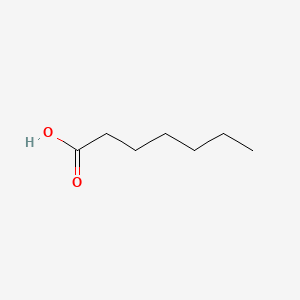| MeSH term | MeSH ID | Detail |
|---|---|---|
| Olfaction Disorders | D000857 | 17 associated lipids |
| Byssinosis | D002095 | 11 associated lipids |
| Mitochondrial Diseases | D028361 | 25 associated lipids |
HEPTANOIC ACID
HEPTANOIC ACID is a lipid of Fatty Acyls (FA) class. Heptanoic acid is associated with abnormalities such as Dehydration. The involved functions are known as Process, Anabolism, inhibitors, Oxidation and fatty acid oxidation. The related lipids are Heptanoates and undecanoic acid.
Cross Reference
Introduction
To understand associated biological information of HEPTANOIC ACID, we collected biological information of abnormalities, associated pathways, cellular/molecular locations, biological functions, related genes/proteins, lipids and common seen animal/experimental models with organized paragraphs from literatures.
What diseases are associated with HEPTANOIC ACID?
HEPTANOIC ACID is suspected in Dehydration and other diseases in descending order of the highest number of associated sentences.
Related references are mostly published in these journals:
| Disease | Cross reference | Weighted score | Related literature |
|---|
Possible diseases from mapped MeSH terms on references
We collected disease MeSH terms mapped to the references associated with HEPTANOIC ACID
PubChem Associated disorders and diseases
What pathways are associated with HEPTANOIC ACID
There are no associated biomedical information in the current reference collection.
PubChem Biomolecular Interactions and Pathways
Link to PubChem Biomolecular Interactions and PathwaysWhat cellular locations are associated with HEPTANOIC ACID?
There are no associated biomedical information in the current reference collection.
What functions are associated with HEPTANOIC ACID?
Related references are published most in these journals:
| Function | Cross reference | Weighted score | Related literatures |
|---|
What lipids are associated with HEPTANOIC ACID?
Related references are published most in these journals:
| Lipid concept | Cross reference | Weighted score | Related literatures |
|---|
What genes are associated with HEPTANOIC ACID?
There are no associated biomedical information in the current reference collection.
What common seen animal models are associated with HEPTANOIC ACID?
There are no associated biomedical information in the current reference collection.
NCBI Entrez Crosslinks
All references with HEPTANOIC ACID
Download all related citations| Authors | Title | Published | Journal | PubMed Link |
|---|---|---|---|---|
| Kamischke A et al. | An effective hormonal male contraceptive using testosterone undecanoate with oral or injectable norethisterone preparations. | 2002 | J. Clin. Endocrinol. Metab. | pmid:11836281 |
| Decker R et al. | Combined treatment with testosterone (T) and ethinylestradiol (EE2) in constitutionally tall boys: is treatment with T plus EE2 more effective in reducing final height in tall boys than T alone? | 2002 | J. Clin. Endocrinol. Metab. | pmid:11932294 |
| O'Connor DB et al. | Exogenous testosterone, aggression, and mood in eugonadal and hypogonadal men. | 2002 | Physiol. Behav. | pmid:12062320 |
| Kemenes I et al. | Critical time-window for NO-cGMP-dependent long-term memory formation after one-trial appetitive conditioning. | 2002 | J. Neurosci. | pmid:11850468 |
| Avrahami D and Shai Y | Conjugation of a magainin analogue with lipophilic acids controls hydrophobicity, solution assembly, and cell selectivity. | 2002 | Biochemistry | pmid:11841217 |
| Singh AB et al. | The effects of varying doses of T on insulin sensitivity, plasma lipids, apolipoproteins, and C-reactive protein in healthy young men. | 2002 | J. Clin. Endocrinol. Metab. | pmid:11788637 |
| Ventura R et al. | Quantification of perphenazine in eurasian otter (Lutra lutra lutra) urine samples by gas chromatography-mass spectrometry. | 2002 | J. Chromatogr. B Analyt. Technol. Biomed. Life Sci. | pmid:11936697 |
| Cherrier MM et al. | Cognitive effects of short-term manipulation of serum sex steroids in healthy young men. | 2002 | J. Clin. Endocrinol. Metab. | pmid:12107206 |
| Mouri T et al. | [Magnetoencephalographic responses to odor and non-odor by fast Fourier transformation analysis in humans]. | 2002 | Nippon Jibiinkoka Gakkai Kaiho | pmid:11905051 |
| Sinha-Hikim I et al. | Testosterone-induced muscle hypertrophy is associated with an increase in satellite cell number in healthy, young men. | 2003 | Am. J. Physiol. Endocrinol. Metab. | pmid:12670837 |
| Crescioli C et al. | Inhibition of spontaneous and androgen-induced prostate growth by a nonhypercalcemic calcitriol analog. | 2003 | Endocrinology | pmid:12810561 |
| Zitzmann M et al. | Prostate volume and growth in testosterone-substituted hypogonadal men are dependent on the CAG repeat polymorphism of the androgen receptor gene: a longitudinal pharmacogenetic study. | 2003 | J. Clin. Endocrinol. Metab. | pmid:12727953 |
| Matsunami H and Amrein H | Taste and pheromone perception in mammals and flies. | 2003 | Genome Biol. | pmid:12844351 |
| Bondanelli M et al. | Activation of the somatotropic axis by testosterone in adult men: evidence for a role of hypothalamic growth hormone-releasing hormone. | 2003 | Neuroendocrinology | pmid:12845224 |
| Herbst KL et al. | The male contraceptive regimen of testosterone and levonorgestrel significantly increases lean mass in healthy young men in 4 weeks, but attenuates a decrease in fat mass induced by testosterone alone. | 2003 | J. Clin. Endocrinol. Metab. | pmid:12629101 |
| Mauras N et al. | Synergistic effects of testosterone and growth hormone on protein metabolism and body composition in prepubertal boys. | 2003 | Metab. Clin. Exp. | pmid:12898459 |
| Chu KS et al. | The antinociceptive effect of nalbuphine and its long-acting esters in rats. | 2003 | Anesth. Analg. | pmid:12933406 |
| Altamura AC et al. | Intramuscular preparations of antipsychotics: uses and relevance in clinical practice. | 2003 | Drugs | pmid:12600227 |
| Klatt CG and LaPara TM | Aerobic biological treatment of synthetic municipal wastewater in membrane-coupled bioreactors. | 2003 | Biotechnol. Bioeng. | pmid:12599258 |
| Weinbauer GF et al. | Pharmacokinetics and degree of aromatization rather than total dose of different preparations determine the effects of testosterone: a nonhuman primate study in Macaca fascicularis. | 2003 Sep-Oct | J. Androl. | pmid:12954670 |
